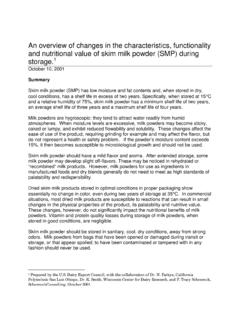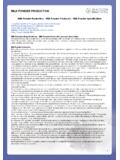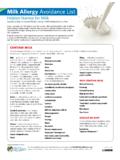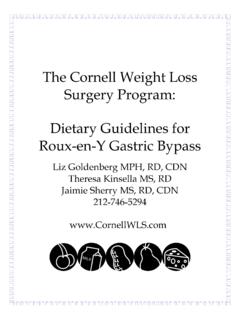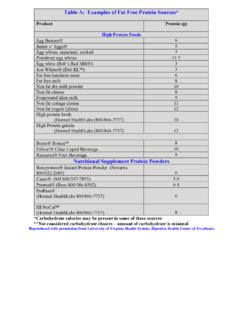Transcription of Calf Milk Replacer Guide - Merrick's
1 calf milk Replacer Guide Developed by Rob Costello, Technical Specialist Merrick s Inc., 2012 Why Feed milk Replacer ? Most dairy calves in the United States are fed milk Replacer during their liquid feeding period. Economics, convenience and biosecurity are among the major factors that make milk Replacer feeding desirable to dairy calf growers. Economics. It is typically cheaper to feed milk Replacer to dairy calves than it is to feed saleable whole milk . milk replacers are made from byproducts of the milk manufacturing industry. Whey, the major protein source for milk replacers, is a byproduct of cheese manufacturing and is usually much cheaper than other milk protein sources such as casein and skim milk . The use of high quality, lower cost ingredients makes milk Replacer a more economic choice than whole milk .
2 Directions: Enter the required values in boxes a and c. Carry out the calculations and enter the results in boxes b and d. Example: You receive $ per hundredweight (cwt) of milk and pay $ for a 50 lb bag of milk Replacer . Your savings is $ per 50 lb bag of milk Replacer used. Convenience. milk replacers offer a variety of choices when it comes to ingredients and nutrient levels. This provides flexibility that makes it easier for a variety of farms to meet their management needs. Additives such as vitamins and medications (antibiotics, coccidiostats and ionophores) can easily be supplied through milk Replacer . Adding them by hand can be a challenge in whole milk feeding systems. In addition, protein and fat levels in milk replacers can be selected to enhance calf growth objectives and to respond to climatic conditions.
3 Biosecurity. Calves are especially vulnerable to disease. Diseases such as Johne s, Bovine Viral Diarrhea, Bovine Leukosis Virus, pasteurella, salmonella, E. coli and mycoplasma can be transmitted from cow to calf through unpastuerized milk . Biosecurity and disease prevention issues contribute greatly to the popularity and use of milk replacers. Merrick s not only purchases pasteurized milk ingredients for making milk replacers, but we also include pasteurization as a key step in our manufacturing process. Potential Savings When Feeding milk ReplacerInste ad Of Whole M ilkPrice you receive for 100 lb of whole milk ($/cwt)aTimes4 Value of 400 lb of whole milk (50 lb solids1)EqualsbCost of 50 lb of milk replacerMinuscSavingsEqualsdSource: BAMN 19981 Whole milk is approximately solids: 400 lb x = 50 lb solids.
4 Therefore 50 lb of calfmilk Replacer will replace 400 lb of whole milk . This is the average amount of milk required to feeda calf from birth to weaning 2012 Merrick s Inc., milk Replacer Guide 1 milk Replacer Ingredients Protein The general recommendation for milk Replacer protein level is 20 to 27 percent. The most common levels used by calf raisers are 20 to 22 percent. Higher protein levels are usually reserved for intensive milk Replacer feeding programs designed to increase calf growth rate. With these programs, the increase in protein percentage coincides with an increase in milk Replacer feeding rate and a decrease in milk Replacer fat percentage. milk Proteins are typically more highly digestible than non- milk proteins and provide a desirable amino acid profile for calf growth.
5 Many different milk products are used in manufacturing milk replacers. These include whey, whey protein concentrate, delactosed whey, skim milk , and casein. Whey products are currently utilized as principal protein sources in milk replacers. Protein sources are typically the most expensive milk Replacer ingredients. Whole MilkSeparationCheesemakingCreamButterSki m MilkDryingCaseinNon-fat DriedSkim MilkAc i dPrecipitationCurdsCheeseLiquid WheyUltrafiltrationDryingWhey PowderLactoseDelactosedWhe yCrystallizationPermeateWhey ProteinConcentrateDryingWhe yFat2 2012 Merrick s Inc., milk Replacer Guide Whey and Skim milk Proteins In the early days of calf milk replacers, skim milk was the primary protein source. Alternative uses of skim milk resulted in decreased availability of the ingredient for milk Replacer manufacturing and increased the price of skim milk relative to whey proteins.
6 As a result, whey proteins became the primary protein sources for milk replacers. Today, whey proteins remain the major protein source for calf milk replacers. Research into the nutritional value of whey and skim milk proteins and their impact on calf growth demonstrates that whey proteins are equal to skim milk . It can even be argued that whey proteins are superior to skim milk : 1. Whey and whey protein concentrate contain lactalbumin protein while skim milk contains a combination of casein-lactalbumin protein. Studies comparing the Protein Efficiency Ratio (PER)1 of milk proteins show whey proteins to be a superior form of digestible protein. 2. Researchers at the Pennsylvania State University (Terosky et al, 19972) looked at four dietary ratios of dried skim milk and whey protein concentrate as primary protein sources in calf milk replacers.
7 The four test diets were expressed as ratios of dried skim milk to whey protein concentrate, 100:0, 67:33, 33:67 and 0:100. Although no significant differences were noted in health or growth parameters, the researchers did find that the apparent biological value (BV3) and N retention differed among diets over all weeks. Apparent digestibility and apparent biological value of the all skim milk diet were and respectively. These values were surpassed by the all whey protein concentrate diet, where the apparent digestibility and apparent BV were and , respectively. 2 1997 J Dairy Sci. 80:2977 2983 3 Biological Value (BV): is the proportion of absorbed protein retained in the body Protein Efficiency Ratio (PER) Of milk By-products* Whey Whey Protein Concentrate Lactalbumin Skim milk Casein *Based on published studies by the New Zealand Dairy Board, 1984 1 Protein Efficiency Ratio (PER) is the gain in weight of growing animals per gram of protein eaten 2012 Merrick s Inc.
8 , milk Replacer Guide 3 Egg Proteins have been incorporated into commercial milk replacers for several years with excellent results. Egg proteins are often referred to as the perfect protein and have been used as the standard for evaluating proteins. Their amino acid content and digestibility are the reference against which all other proteins are compared. Egg proteins are also less expensive than milk proteins, thereby reducing the cost of milk Replacer . Eggs can also be utilized as a source of energy (eggs are 37% fat), iron, phosphorous, trace minerals and vitamins. They are an important source of lecithin (about 8-9% lecithin in egg yolk). Lecithin acts as a natural antioxidant as well as a skin and hair conditioner, and is a source of choline which is associated with positive hair coat characteristics.
9 Merrick s unique manufacturing process begins with liquid whole eggs and is fundamental in obtaining the excellent calf performance results achieved with our egg enriched milk replacers. Liquid eggs are thoroughly mixed with our other liquid ingredients. This mixture is pasteurized and then spray dried to make the milk Replacer powder. Alternative processes that rely on mixing dried egg components in a dry blending process often result in reduced calf performance. Feeding eggs to calves is not a new concept. It wasn t long ago that parents or grandparents cracked an egg into a calf s milk to give it something extra to help it to a better start or help it through a case of calf scours. Obviously, egg is not just a home remedy. Animal Plasma Proteins provide a unique protein source that contains active albumin and globulin proteins such as IgG and IgM.
10 This highly soluble, high quality protein source has an amino acid profile and nutritive value comparable to nonfat dried (skim) milk and casein. In the digestive tract, IgG has a direct effect on pathogens and may also have a direct effect on the intestinal lining, or mucosa. Animal plasma is obtained by centrifuging whole blood into its major components, plasma and blood cells. The two main types of animal plasma are bovine (ruminant) and porcine (swine). Animal plasma of porcine origin is exclusively used in Merrick s calf products. Whole BloodBlood MealPlasmaBlood CellsCentrifugeSpray DryAdd AnticoagulantChill and ScreenUltrafiltration orReverse OsmosisSpray DrySpray DriedPlasma4 2012 Merrick s Inc., milk Replacer Guide Wheat Protein Isolate is the wheat ingredient used in Merrick s wheat protein milk replacers, providing a high quality, economical protein source.

